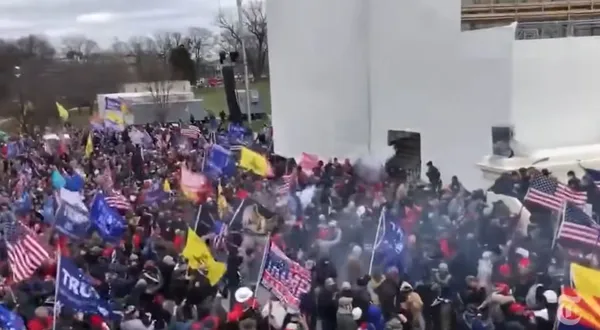Eye For Film >> Movies >> Day Of Rage: How Trump Supporters Took The US Capitol (2021) Film Review
Day Of Rage: How Trump Supporters Took The US Capitol
Reviewed by: Jennie Kermode

Shortlisted for the 2022 Oscars, this short documentary by the investigative team at the New York Times endeavours to establish a definitive, if not exhaustive, record of the assault on the US Capitol building by a mob of civilians on 6 December 2020. It is the culmination of six months’ work in collecting, analysing and mapping footage of the event in conjunction with official records, creating a timeline of events in and around the building, identifying groups and key individuals and detailing what took place.
It’s a film which works on two levels: firstly as a fascinating account of a historic event, and secondly as a revealing illustration of how different segments of US society see themselves. It’s evident that many of those visible in footage of the event are just ordinary people who are not looking for trouble but have simply bought into a misleading narrative and feel it’s their duty to protest what they believe to be the theft of an election. These are people who see themselves as dutiful citizens, or as heroes, and in different circumstances they might very well be that. Alongside them, however, are organised groups whose allegiance to far right extremist causes is clear. We see members of the Proud Boys and the Oath Keepers. It’s bizarre to hear Antifa treated as equivalent to them and described as ‘far left agitators’ – an attempt at balance, perhaps, which recalls Donald Trump’s famous comments about the violence in Charlottesville in 2017. There’s also a shocking naivety apparent when the building is described as “what appeared to be an impenetrable institution of government.”
One of the most notable things about the crowd around the Capitol, even before the violence begins, is that it’s a sea of white faces – unmasked, of course. A single ‘blacks for Trump’ placard is visible within it. Some of those who riot are clad in pseudo-military gear; one carries a Confederate flag. In an astonishing act of bravery, a solitary black security official holds them at bay in the lobby; then, when that position becomes untenable, leads them away from a vulnerable area and into a line of fellow officers. Watching footage of the country’s nuclear launch equipment hurriedly being carried to safety, one wonders what might have happened without him.
The interweaving of footage from numerous different sources makes it possible to track the paths of key individuals as they move through the chaos around them: those who seem to have specific agendas, those who found themselves becoming prominent almost by accident, and those who were unlucky. At one point a mocking chant of “I can’t breathe” rises up from the rioters as they unwittingly trample one of their own, a woman who has fainted, to death. Meanwhile, intended targets are hustled to safety – as much as possible. Some make it out of the building, some to the basement. Elsewhere, we see frightened staffers huddled together in offices, trying to block the doors with barricades made out of sofas. Nancy Pelosi’s team hides under a table. The popular belief that those close to power are a different kind of people is quickly stripped away. We see their humanity, their fear and, in many cases, their struggle to believe what is happening to them.
What happens if one goes along to a protest with peaceful intentions only to be caught up, almost literally, in the tide of history? It’s clear that once they find themselves inside the building, many have no idea what to do. They mill around aimlessly, gazing at symbols of power which they normally only see on television. Some make excited speeches; others seem completely bewildered. Still others behave like drunken teenagers or nervous monkeys, smashing up everything in sight and triumphantly strewing the floors with papers. This doubtless provides useful cover for anyone wanting to steal a particular document, but it must also make it significantly harder for them to find what they’re after.
Contextualising the scenes captured on TV cameras, security cameras and rioters’ own phones are maps of the building, diagrams and pieces of enhanced footage illustrating the movement of key figures and crowds. This will be the first time most viewers have had the opportunity to observe what happened in detail and to identify the strategic and chaotic actions on both sides. Watching police officers struggle to hold the line, afraid for their lives and acutely aware that they’re overwhelmed, it’s distressing to hear how long it took for them to receive any kind of back-up. This kind of detail may prompt viewers to attach political weight to the unfolding story, but curious though this may sound, there is a good deal to appreciate in the film regardless of one’s political perspective. It will particularly appeal to those with an interest in war films, historical documentaries and studies of the behaviour of crowds.
Reviewed on: 14 Jan 2022















